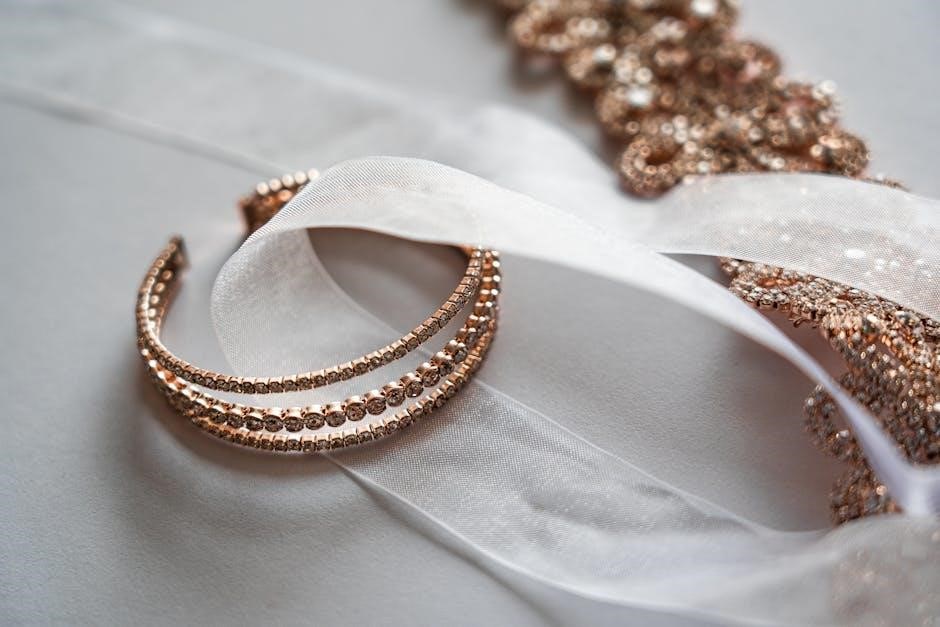4 c’s of diamonds chart pdf
- Published
- in PDF
The 4 Cs of Diamonds—Cut, Color, Clarity, and Carat—are essential for evaluating diamond quality. They guide consumers in understanding a diamond’s characteristics, ensuring informed purchasing decisions.
Overview of the 4 Cs Chart
The 4 Cs Chart is a comprehensive framework used to evaluate diamonds based on Cut, Color, Clarity, and Carat. This chart provides a standardized method to assess and compare diamonds, ensuring consistency in grading. Each category is divided into sub-grades, allowing for precise evaluation. The chart helps consumers and professionals understand how these factors collectively determine a diamond’s quality and value. By referencing the 4 Cs Chart, buyers can make informed decisions, balancing their priorities among the four key characteristics. This tool is essential for navigating the complexities of diamond selection and ensuring satisfaction with the final choice.
Importance of Understanding the 4 Cs
Understanding the 4 Cs—Cut, Color, Clarity, and Carat—is crucial for evaluating diamond quality and value. These criteria provide a standardized method to assess diamonds, ensuring buyers make informed decisions. Knowledge of the 4 Cs helps consumers compare diamonds accurately, balancing their preferences and budget. It also aids in identifying a diamond’s unique characteristics, ensuring satisfaction with the purchase. By grasping these principles, individuals can navigate the market confidently, avoiding costly mistakes. The 4 Cs are the foundation of diamond evaluation, making their understanding essential for anyone seeking to invest in a high-quality diamond.

The First C: Cut
Cut refers to a diamond’s proportions, symmetry, and polish, determining its sparkle and brilliance. It is the most critical factor in a diamond’s overall appearance and value.
Understanding Diamond Cut and Its Impact on Brilliance
Diamond cut determines how light interacts with the stone, affecting its brilliance and fire. A well-cut diamond refracts light internally, maximizing sparkle and scintillation. Cut includes proportions, symmetry, and polish, with ideal cuts balancing these factors for optimal brilliance. Poorly cut diamonds lose light through the base or sides, appearing dull. The cut’s quality significantly impacts a diamond’s value, as it directly influences visual appeal. Understanding cut proportions, such as table size and depth percentages, helps identify diamonds with superior light performance, ensuring maximum brilliance and fire.
Key Factors in Determining Diamond Cut Quality
Proportions, symmetry, and polish are the primary factors in evaluating diamond cut quality. Ideal proportions ensure maximum brilliance, while symmetry refers to the alignment of facets. Polish affects surface quality, with higher grades indicating fewer inclusions. Table size and depth percentages are critical, as they influence light performance. A well-cut diamond with precise angles and minimal flaws achieves superior sparkle. Poor cut quality can lead to light leakage, reducing brilliance. These factors, graded by organizations like GIA, help determine a diamond’s value and aesthetic appeal.
How to Identify an Ideal Cut Diamond
An ideal cut diamond exhibits exceptional brilliance and fire due to precise proportions, symmetry, and polish. Look for a table size between 55-58% and depth around 59-62% for round diamonds. Facet angles should align closely with ideal standards. Symmetry refers to the alignment of facets, with “excellent” or “ideal” grades indicating superior craftsmanship. Polish ratings of “excellent” or “very good” ensure a smooth surface. An ideal cut maximizes light performance, offering unparalleled sparkle. Always consult a grading report, like those from GIA, to confirm these characteristics, ensuring your diamond meets the highest cut quality standards.

The Second C: Color
Diamond color is graded from D (colorless) to Z (light yellow/brown). The grade affects value, with colorless diamonds being rare and more valuable. Subtle differences matter.
Diamond Color Grading Scale
The diamond color grading scale ranges from D (colorless) to Z (light yellow or brown). D-F are colorless, G-J near colorless, and K-Z have noticeable color. The scale, developed by GIA, measures how closely a diamond approaches colorlessness. Colorless diamonds (D-F) are rare and highly valued, while those with more color (K-Z) are less valuable. Subtle differences between grades significantly impact value and brilliance. Labs like GIA use precise tools to grade color under controlled lighting. Understanding this scale helps consumers identify a diamond’s quality and make informed purchasing decisions, ensuring they balance color preferences with budget and other diamond characteristics.
How Color Affects a Diamond’s Value
Diamond color significantly impacts its value, as colorless diamonds are rarer and more desirable. On the GIA grading scale, diamonds graded D-F are colorless and highly prized, commanding premium prices. As color becomes more noticeable (G-Z), the diamond’s value decreases. Even slight variations in color can lead to substantial price differences. Color affects brilliance, with colorless diamonds refracting light more effectively, enhancing sparkle; While some may prefer the warmth of diamonds with slight color, understanding this grading system helps consumers balance their budget with their preferences, ensuring they find a diamond that aligns with their desired quality and aesthetic appeal.
Detecting Color in Diamonds
Detecting color in diamonds requires careful examination under controlled lighting. The GIA grading scale categorizes diamonds from D (colorless) to Z (light yellow or brown). Colorless diamonds (D-F) are rare and highly valued, while those with noticeable color (G-Z) are less valuable. To detect color, compare diamonds side by side under bright, neutral lighting. A jeweler’s loupe or gemscope can help identify subtle variations. Even slight traces of color can impact value significantly. Professional grading reports from organizations like GIA provide accurate assessments, ensuring consumers make informed decisions when selecting their diamond.

The Third C: Clarity
Clarity refers to the presence or absence of inclusions and blemishes in a diamond. It impacts the diamond’s transparency and brilliance, with higher clarity grading indicating fewer imperfections.
Types of Inclusions and Blemishes

Diamond clarity is determined by the presence of inclusions (internal imperfections) and blemishes (external imperfections). Common inclusions include feathers, clouds, black dots, and cavities, while blemishes like scratches or pits occur during cutting. The size, number, and location of these imperfections affect a diamond’s clarity grade. Higher clarity grades (Flawless to Slight Inclusions) indicate fewer or less noticeable imperfections, preserving brilliance and value. Understanding these factors helps in assessing a diamond’s transparency and overall appearance, ensuring informed decisions when selecting a stone.
Clarity Grading Scale and Its Significance
The clarity grading scale, developed by the Gemological Institute of America (GIA), ranges from Flawless (FL) to Included (I), with subdivisions like Internally Flawless (IF), Very Very Slightly Included (VVS), Very Slightly Included (VS), Slightly Included (SI), and Included (I). This scale evaluates the presence and visibility of inclusions and blemishes, which affect a diamond’s brilliance and value. Higher clarity grades indicate fewer imperfections, enhancing the diamond’s transparency and light performance. While flawless diamonds are rare and costly, lower clarity grades can still offer beauty and value, making the clarity grading scale a critical tool for balancing quality and budget.
Enhancing Clarity in Diamonds
Clarity can be enhanced through various treatments, such as laser drilling or fracture filling, which reduce the visibility of inclusions. These methods improve a diamond’s transparency and brilliance without altering its natural characteristics. However, such treatments must be disclosed to maintain ethical standards. High-pressure high-temperature (HPT) treatments can also alter inclusions, but their effects on value and resale are debated. While these techniques can upgrade a diamond’s clarity grade, they may impact its long-term worth. Always work with reputable professionals to ensure clarity enhancements are done transparently and ethically.

The Fourth C: Carat
Carat measures a diamond’s weight, with larger stones being rarer and more valuable. Understanding carat size helps balance quality and budget in your diamond selection process.
Carat Weight vs. Diamond Size

Carat refers to a diamond’s weight, while size describes its dimensions. A higher carat weight doesn’t always mean a larger appearance, as size depends on cut and proportions. Diamonds with the same carat weight can vary in size due to differences in cut quality and shape. Understanding this distinction helps in balancing carat weight with other factors like cut and clarity. While carat weight significantly impacts value, perceived size is also influenced by how well the diamond is cut. This relationship is crucial for making informed decisions when selecting a diamond that aligns with your preferences and budget.
Price per Carat and Its Implications
Price per carat is a critical factor in determining a diamond’s value, as larger diamonds are rarer and command higher prices. The cost per carat increases with carat weight, meaning a 2-carat diamond costs more per carat than a 1-carat diamond of similar quality. This pricing structure reflects the rarity and desirability of larger stones. Understanding price per carat helps buyers evaluate whether a diamond’s size justifies its cost. It also highlights the importance of balancing carat weight with cut, color, and clarity to maximize value and beauty.
Balancing Carat with Other Cs
Balancing carat with cut, color, and clarity is crucial for maximizing a diamond’s beauty and value. While larger diamonds are rarer and more desirable, they may lack brilliance or purity if other Cs are compromised. For instance, a high-carat diamond with poor cut or visible inclusions may appear less dazzling than a smaller, well-cut diamond with better clarity. Personal preferences play a significant role; some prioritize size, while others value sparkle or color. Using the 4 Cs chart helps identify trade-offs, ensuring the diamond aligns with both budget and aesthetic goals. Striking this balance ensures a diamond that is both visually stunning and a wise investment;

Importance of the 4 Cs in Diamond Evaluation
The 4 Cs are fundamental for assessing a diamond’s value, quality, and beauty, making them indispensable for buyers seeking to make informed and confident purchasing decisions.
How the 4 Cs Determine Diamond Value
The 4 Cs—Cut, Color, Clarity, and Carat—collectively determine a diamond’s value by assessing its aesthetic appeal, rarity, and craftsmanship. Cut impacts brilliance and fire, with well-cut diamonds commanding higher prices. Color grades range from colorless to yellow or brown, with rarer colorless diamonds being more valuable. Clarity evaluates inclusions and blemishes, where fewer imperfections increase worth. Carat measures weight, with larger diamonds being rarer and more expensive. Together, these factors create a comprehensive system to evaluate and price diamonds, ensuring transparency and consistency in the market.
Role of the 4 Cs in Diamond Certification
The 4 Cs play a pivotal role in diamond certification by providing a standardized method to assess and document a diamond’s qualities. Cut, Color, Clarity, and Carat are meticulously evaluated by gemological laboratories, such as the GIA, to determine a diamond’s authenticity and grade. Each factor is analyzed independently, ensuring unbiased and precise certification. This process guarantees transparency, allowing consumers to trust the quality and value of their diamond. The 4 Cs certification is a cornerstone of the diamond industry, ensuring consistency and reliability in grading and valuation.

How to Choose Your Diamond Using the 4 Cs Chart
The 4 Cs provide a clear framework to evaluate diamonds. Use the chart to compare Cut, Color, Clarity, and Carat, guiding you to make informed purchasing decisions.
Step-by-Step Guide to Selecting the Perfect Diamond
To select the perfect diamond, start by assessing your budget and preferences. Prioritize the 4 Cs based on what matters most to you. Evaluate the diamond’s Cut for brilliance, ensuring ideal proportions. Next, consider Color, aiming for a grade that aligns with your desired appearance. Assess Clarity by examining inclusions and blemishes under magnification. Measure Carat weight to balance size and value. Use the 4 Cs chart for comparison, ensuring the diamond meets your criteria. Finally, consult a gemologist or trusted jeweler to verify quality and authenticity.
Using the 4 Cs Chart for Comparison
The 4 Cs chart is a valuable tool for comparing diamonds based on Cut, Color, Clarity, and Carat. By evaluating each diamond’s grades across these categories, you can identify differences in quality and value. Start by comparing Cut grades to ensure optimal brilliance, then review Color grades to find the desired whiteness or hue. Next, examine Clarity grades to assess inclusions and blemishes. Finally, compare Carat weights to balance size with budget. Using the chart, you can side-by-side analyze diamonds, ensuring your choice aligns with your priorities and budget, while understanding how each C impacts the diamond’s overall appeal and value.

Future Trends in Diamond Grading and the 4 Cs
Emerging technologies like AI and automated grading tools are reshaping diamond evaluation. Synthetic diamonds are also influencing grading standards, ensuring greater accuracy and transparency in the industry.
Emerging Technologies in Diamond Grading
Emerging technologies like AI-powered grading tools and automated diamond analysis systems are revolutionizing the 4Cs evaluation process. These advanced systems provide precise measurements and consistency, reducing human error. Synthetic diamonds, created in labs, are also impacting grading standards, offering a more sustainable option. Blockchain technology is being integrated to enhance certification transparency, ensuring authenticity and traceability. These innovations are transforming how diamonds are assessed, making the process faster, more accurate, and accessible to consumers worldwide. As technology evolves, it promises to redefine diamond grading, ensuring higher standards and greater consumer confidence.
The 4 Cs—Cut, Color, Clarity, and Carat—are fundamental in evaluating diamonds, guiding consumers to make informed decisions. Understanding these factors ensures selecting a diamond that meets personal preferences and budget, balancing quality and value effectively.
Final Thoughts on the 4 Cs of Diamonds
The 4 Cs—Cut, Color, Clarity, and Carat—are indispensable for evaluating diamonds, ensuring a balanced and informed purchase. Each factor contributes uniquely to a diamond’s brilliance, rarity, and value. While personal preferences may prioritize one C over others, understanding their interplay helps in selecting a diamond that aligns with both budget and beauty. By mastering the 4 Cs, consumers can confidently navigate the market, making decisions that reflect their style and investment goals. Ultimately, the 4 Cs chart serves as a timeless guide, empowering buyers to find their perfect diamond with clarity and confidence.
